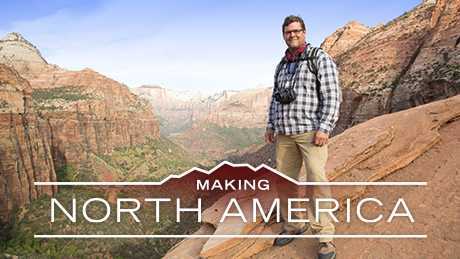
The PBS series NOVA has a three-part series coming out next week called “Making North America.” Hosted by the director of the Smithsonian Institution’s National Museum of Natural History, Kirk Johnson, the series will explore the tectonic assembly of terranes that resulted in the bedrock of the continent, the panoply of diverse creatures that have dwelled here in the past, and the human prehistory of our continent. I was given press access to review the episodes in advance. I’ll cover them one by one.
Episode 1 is the most explicitly geological of the three. It begins, of course, at the Grand Canyon, and while that location is almost a cliché (as is the red-tailed hawk call they played over footage of a wheeling vulture), they did something new, innovative, and worthwhile with it: While on a (gratuitous) rappel down a cliff of Esplanade Sandstone, Kirk made the point that each layer in the Grand Canyon’s stratigraphy is a snapshot of conditions on Earth’s surface at one point in time. Then, through CGI, individual layers slide out of the canyon walls, each depicting on a hovering slab of rock the depositional environment that is the best interpretation of that layer’s formative conditions: shallow seas, sand dunes, swamps, etc. This is the point I try to drive home with my Historical Geology courses, and the floating slabs of ancient depositional environments was an elegant way of expressing it.
A consistently used, though understated, digital enhancement was showing a brief glowing grid pass over Kirk’s glasses, and then in the next scene you see that grid “mapping” the landscape under his gaze. It’s as neat a representation as I’ve seen of “seeing the world through geology colored glasses.”
Another CGI effect was the evolution of paleogeography over time, using what appears to be a “tweening” method for extrapolating steps between static paleogeographic reconstructions. The technique, however, results in a jittery sort of time lapse, as the continental bits pulse and squirm back and forth. To me, this raises the possibility of an intriguing test of the validity of these paleogeographic reconstructions – do the sudden, temporary reversals in motion accurately reflect our understanding of the data that under-gird the paleogeographic interpretations? Of course, plates can shift direction, but watching these pulsating blobs of crust carom across the screen struck me as mildly inelegant, perhaps even carrying an unparsimonious scent with their inconsistent velocities.
Speaking of CGI, I think the simplest and most effective use of digital special effects were on the segment that looked at the San Andreas Fault. At one point, Kirk and another geoscientist sit on the North American Plate at Tomales Bay, and across the water, Point Reyes heads northwestward at several feet per second. Cool effect. A moment later, the camera swoops over the Hollywood sign and crests the ridge to reveal… the Golden Gate Bridge! It’s a clever way of showing the eventual juxtaposition of Los Angeles and San Francisco through fault motion.
Another fun moment came during a scene prospecting on an Alaskan beach for fossil palm fronds… The talented artist Ray Troll, Kirk Johnson’s companion in the awesome Cruisin’ the Fossil Freeway, makes a cameo appearance. Kirk himself delivers a solid performance – the enthusiastic, knowledgeable goof. His easy-going demeanor makes him very approachable as host, I would say. Some of the conversations that ensue are unbelievable as verbatim exchanges between two professional geologists, but I think the acting parlays the simplified essential points for the non-specialist audience.
I appreciate the attempt to make the point that partial melting of basalt can yield a magma with a more felsic composition, but it was definitely presented in a lowest-common-denominator kind of way: glossing over the details but making the point that continental crust is derived from the recycling of oceanic crust. Much of the exposition in the episode is like this: simple enough for non-specialists to comprehend, but probably too simplified for specialists to fully embrace. There’s a lot of repetition too – which would probably make the series a good choice for school groups. A good deal of attention was paid to the Mid-Continent Rift (under Lake Superior), and I liked referring to Rodinia as a continental “group hug,” as well as upgrading Pangaea from a supercontinent to a megacontinent. I cringed at the use of “Taconic Mountains” for the Taconian Mountain range, Alpine in size and Ordovician in age. (You can visit the Taconic Mountains today – really, we are a vocabulary rich science, and there’s no need to use the same geographic term for ancient huge mountains and modern piddly mountains.) There was a cool exploration of thinking through the discovery of an unusual geological observation, and coming up with a valid interpretation (seismically-induced sand volcanoes cross-sectioned at Zion National Park).
One final note: of the named experts that were interviewed or featured in the episode, two were women and two were men. Excellent job, NOVA, on getting the gender balance right.
“Making North America,” episode 1: Origins will air next Wednesday on your local PBS station.

Nice review, Cal. May we look forward to the program making a powerful explanation of radiometric dating?
It gets a brief mention here, but it’s not especially detailed.